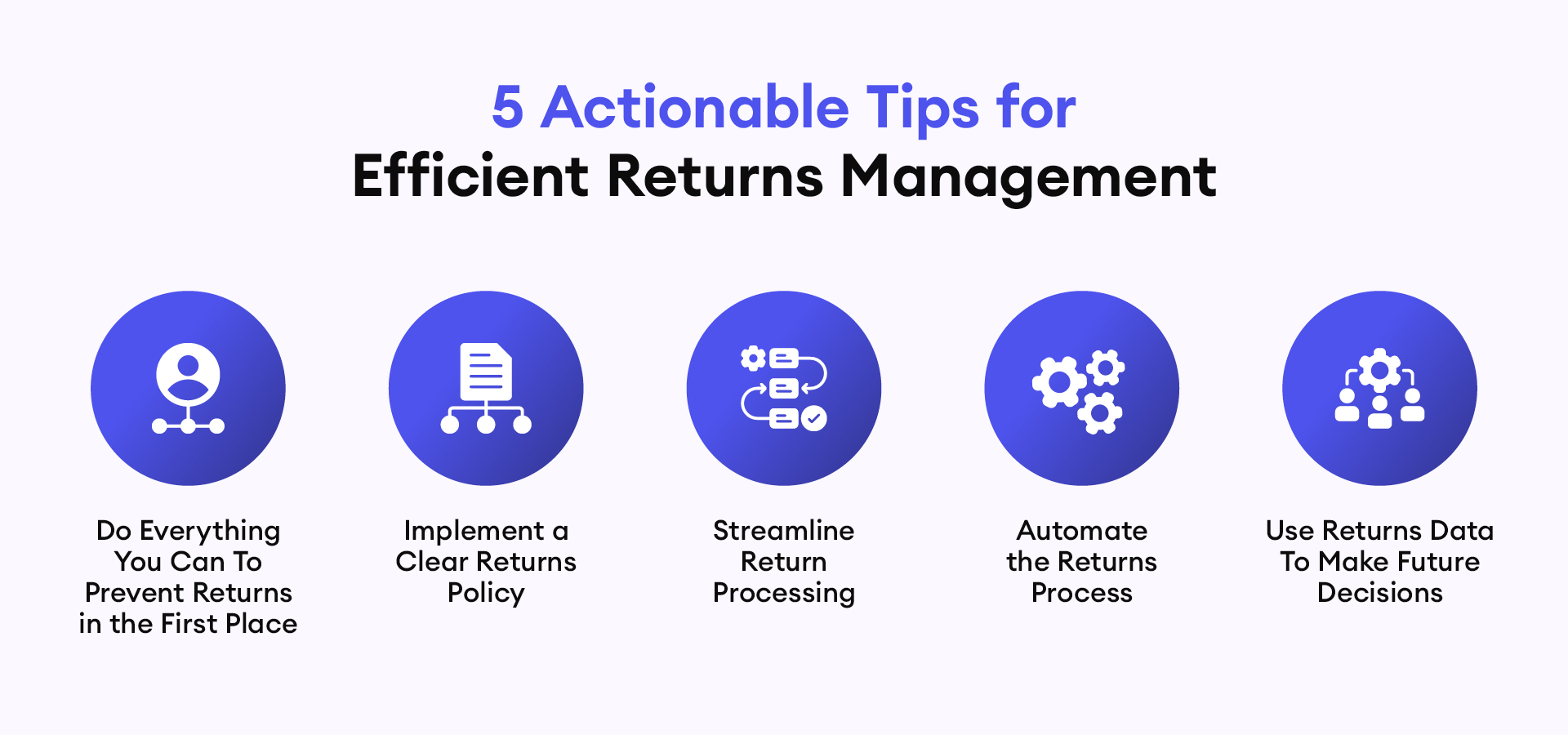5 Actionable Tips to Master Ecommerce Returns (and Cut Costs)

Handling returns is a challenge for any retailer, but did you know the problem is worse for ecommerce sellers compared to brick-and-mortar stores?
According to studies from the National Retail Federation¹ ecommerce retailers see a higher return rate, with 17.6% of merchandise purchased online returned, compared to just 10.02% for brick-and-mortar retail returns.
Items sold online are returned 75% more than in-person purchases.
When you think about it, it makes sense - especially for items like clothing that can’t be tried on when ordering online. But of course, this poses a problem for ecommerce sellers, as returns result in disrupted inventory, increased costs and potential customer dissatisfaction.
The solution?
Setting up an effective returns management system is crucial for turning this common pain point into an opportunity for operational improvement and customer loyalty.
By the end of this post, you’ll be equipped with actionable tips to reduce the risk of returns as much as possible, and handle them efficiently when they do happen, without harming your inventory management or your bottom line.
The main things ecommerce sellers should focus on when handling returns are:
Prevent avoidable returns
Set a clear return policy
Create a structured returns workflow
Automate wherever possible
Use returns data to improve operations
Why Returns Management Matters
Naturally, returns are a bit more complicated for ecommerce sellers than for brick-and-mortar stores. At a traditional brick-and-mortar store, the shopper can simply bring back the item in person to the shop where they bought it. The item can then be inspected right away, repackaged and, if possible, put back on the shelves.
Handling returns for an ecommerce store, however, is more complicated.
Customers typically need to fill out forms, print shipping labels, and mail the product back.
The product must then be shipped to the correct location, inspected, and processed.
If the item can be resold, it must be repackaged and re-listed in inventory.
This process of products moving “backward” through the supply chain is called reverse logistics, and it’s more expensive than forward logistics. Poorly managed returns can increase operational costs, cause stock issues, and hurt customer retention.
An efficient returns process helps ecommerce sellers:
Reduce stockouts and overstocking
Avoid cash flow problems
Improve customer satisfaction and retention
Minimize environmental waste from returns
5 Actionable Tips for Efficient Returns Management
What changes can you make to your ecommerce business to manage returns more effectively? Here are 5 best practices to follow:

1. Do Everything You Can To Prevent Returns in the First Place
First of all, the best way to handle returns is to prevent them from happening at all. While some returns are inevitable, many can be avoided by improving the customer’s buying experience.
Here are some steps you can take:
Provide accurate product descriptions and images. Ensure all product pages include detailed specifications, high-quality photos, and 360-degree views when possible.
Video can be highly effective for showing off how an item looks and functions.
Offer size guides and virtual try-ons. If you sell clothing, include measurement charts and fit recommendations to help customers pick the right size.
Consider sharing customer reviews and photos, so shoppers can see the item as it looks when worn/used by other consumers.
Analyze customer feedback. Identify common reasons for returns and take proactive steps to fix recurring issues.
Returns can also be a result of avoidable seller mistakes, such as:
Incorrect item shipped
Shipping delays
Wrong quantity
Mislabeled address
Poor packaging resulting in damage
To avoid these issues, make sure to:
Use automated order fulfillment systems to reduce human error.
Always double-check orders before shipping to prevent sending incorrect items.
Partner with reliable carriers to minimize shipping delays.
Use durable, protective packaging to prevent damage and reduce shipping-related returns.
Although you’ll never be able to avoid all returns, with the right preventative measures in place you can greatly reduce the risk of items being sent back.
2. Implement a Clear Returns Policy
The next step is to establish a clear and customer-friendly return policy, so you can set expectations and reduce disputes. The goal is to keep the experience with your brand positive, even if the customer has to return the item.
Your return policy should include:
The return timeframe (e.g., “Returns accepted within 30 days of purchase”)
Conditions for returns (e.g., “Items must be unused and in original packaging”)
Refund or exchange options
Instructions for initiating a return
Avoid legal jargon—write your return policy in clear, straightforward language. Also, you should keep the policy easy to find on your website and include it in order confirmation emails.
Some retailers may think that if they hide their return policy, customer’s won’t take advantage of it. But this is, of course, a mistake. If a customer is unsatisfied with the item, they are going to send it back either way and having a clear return policy will make the experience go more smoothly.
Most shoppers prefer to simply get their money back for the item, but you can entice them to accept store credit by offering them a little more than they paid for the original item if they choose that option.
3. Streamline Return Processing
Once a product has made its way back to your warehouse or fulfillment center, what happens next can make or break your returns workflow. This is the moment where operational efficiency truly matters—delays, disorganization, or poor handling can drive up costs and hurt your customer satisfaction.
There’s a lot of work to do during this step, so ecommerce businesses should aim to streamline it as much as possible.
To make the most of every return, create a structured, repeatable process that allows your team to move quickly and make the right decision about what to do with each item.
Here’s a streamlined approach you can use:
Prep Work: Set up a dedicated return zone in your warehouse, so your staff can do this work without disrupting other flows and processes. Train your staff on return workflows, to reduce handling time.
Step 1: Receive and log the item
Use barcode scanning or automation tools to instantly identify and log the return into your system. This reduces manual entry errors and keeps your inventory up to date.Step 2: Inspect and grade the product
Quickly assess the condition of the item to determine whether it can be restocked, refurbished, or must be discarded. Train your team to follow clear grading criteria for consistency.Step 3: Route the item accordingly
Restocking subpar or damaged items can lead to negative customer experiences, so it’s important to have a clear decision-making process that ensures only high-quality products are reintroduced into the inventory.
Based on your inspection, send the item to the appropriate destination:
Restockable items go back into sellable inventory.
Unsellable items are quarantined, recycled, or liquidated.
Refurbishable items may be converted to a different SKU and relisted.
How do you decide when to restock, refurbish or liquidate the item? Here’s a handy chart to refer to:
Restock the item if… | Liquidate or recycle the item if… |
|
|
Step 4: Update inventory levels in real time
If you're using a system like Goflow, your inventory levels are automatically updated as soon as an item is restocked, ensuring accurate stock counts across all your channels.Step 5: Close the return loop
Trigger any final steps—such as issuing a refund or sending a store credit—and notify the customer so they’re not left waiting.
The goal is to move returned items through your system as efficiently as possible, without guesswork or bottlenecks. With a well-documented returns handling process in place, you’ll reduce turnaround time, minimize errors, and preserve the value of returned inventory.
4. Automate the Returns Process
Dealing with returns manually is slow and error-prone. Instead, automate your return process so you can reduce costs, speed things up and improve the customer experience.
Using a returns management tool with automation built in will make your return process more efficient and will improve customer communication. You can even automate return requests, shipping labels and status updates.
Goflow can help you with automated restocking or disposition. Here’s how it works:
When a return is received, you can choose to restock, quarantine or dispose of the item.
If you restock the item, your inventory will be automatically updated in the correct warehouse location.
Any damaged or unsellable items will be routed to a non-sellable location for separate tracking.
Restocked items will automatically update across all your sales channels.
Goflow also allows you to convert received returns to a different SKU, which is applicable if you want to resell or refurbish the item as used.
5. Use Returns Data To Make Future Decisions
Looking at your returns data is valuable for improving your business decisions. This information will help you to identify trends, issues and areas of your operation that need improvement.
For example, you may be able to spot problems that are causing a high volume of products to be sent back, such as a misleading description or a manufacturing defect. This gives you the chance to fix issues proactively and reduce future returns.
This data can also help you adjust purchasing decisions, improve product descriptions or refine quality control. By analyzing return patterns in the data you can also:
Identify problematic products with high return rates.
Improve product descriptions to set better customer expectations.
Refine packaging to prevent damage-related returns.
Adjust purchasing decisions to avoid overstocking products that frequently get returns.
Of course, you can use tools like Goflow to track returned inventory and make data-driven restocking decisions. You can even use predictive analytics to anticipate future returns trends and make proactive improvements.

Set Yourself Up For Success With Better Ecommerce Returns Management
Of course, ecommerce sellers will never be able to eliminate returns entirely - and they shouldn’t try to. Instead, the goal should be to reduce preventable returns and optimize returns management to improve efficiency, minimize costs and enhance customer satisfaction.
By implementing a clear returns policy, automating workflows and leveraging data insights, you can turn returns into an opportunity for business growth.
Want to spend less time managing returns and more time growing your business?
Goflow makes ecommerce returns faster, smarter, and easier—so you can stay focused on what matters.
Start today by scheduling a demo!
¹ National Retail Federation: 2023 Consumer Returns in the Retail Industry: https://nrf.com/research/2023-consumer-returns-retail-industry
